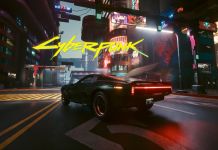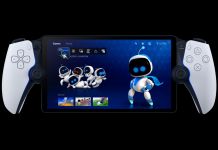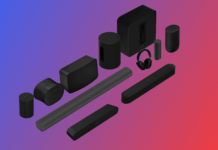Overclocking at Intel is a world unique event that happens on the fall, right before Intel is about to unveil the next generation microprocessor architecture. Liquid nitrogen, tons of hardware and a group of elite overclockers. It just doesn’t get any better than that.
Our faithful readers are most likely aware that we do things a bit different here. While it is very common for every review site to have at least some information on the overclocking potential in their reviews, we try to take things to different level. For the last two years we have visited Intel for a world unique event where we not only get to test Intel’s latest processor and motherboards, but do it in the way we enjoy most: with sub-zero cooling, actually far below zero.
We have a couple of articles planned for the now unveiled Nehalem architecture. This first article covers the days we spent at Intel’s office and laboratory in Stockholm. It all started two years ago when Intel decided to invite Robert ‘crotale’ Kihlberg, Marcus ‘Kinc’ Hultin and myself to come and play with Kentsfield, Intel’s first quad-core processor. One year later we were invited back along with friends and colleagues from around the Nordics.
The Nehalem microarchitecture has been known about for more than a year, and specifics have been revealed bit by bit as we approached the launch. Actual performance and exact specifications have of course remained vague until now. Nehalem has been unveiled and Intel has launched the Core i7 series. It’s based on the processor architecture known as Bloomfield that is Intel’s first native quad-core processor architecture for desktops. We will tell you more about these bits in future articles.
While native is good and all, the major improvements are not that Intel has managed to fit two more cores inside the die, but the new interface known as QPI (QuickPath Interconnect) and that Intel can now move a lot of the northbridge functions on-die. This is not as evident today as it will become when the mid-range and low-end Lynnfield and Havendale cores arrive in Q2. What they all have in common though is that the memory controller is now moved inside the CPU. As we will show you here today, that’s not going to be a real issue when overclocking.
As always we start with the journey.
I should explain and clear out a few things that seem to have been misunderstood in my previous articles. Robert and Marcus were the true heroes of the first event. I assisted when needed and covered their progress. The same goes for the second year where Robert benched together with Sampsa Kurri from Muropaketti. I ended my overclocking career back in 2004 in favor of trying to spread the word and a general lack of time. Getting the opportunity to visit this event is world unique and I feel ever so privileged to be invited.
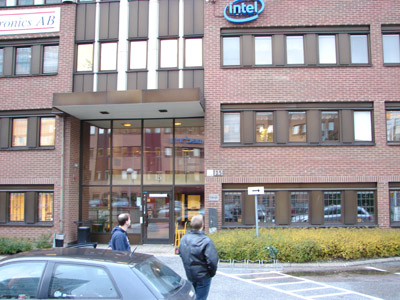 Our first visit … |
If you have read any of my previous articles about the overclocking gatherings at Intel you know that each article started with the story of the journey to Stockholm. The first year things didn’t go exactly as planned, not even close. I’m not going to tell you that old story here, but you should look at the previous articles (2006, 2007) as well for a good read and better understanding of what we do. We finally did arrive at Intel, although a bit late. Myself ( Andreas Galistel), Robert Khilberg and Marcus Hultin, a.k.a. The Human GPS, had been given the unique opportunity to visit Intel and play with their latest toys ehr… I mean processors and motherboards.
The year was 2006 and for the first time ever Intel had actually invited and encouraged overclockers to push its products beyond the stock specifications. As far as I know, this is still a world unique event happening just here in Stockholm, Sweden. We even got a few slides in a recent Intel briefing where the Swedish Intel office showed the rest of the Intel guys how much fun their gadgets can really be, from our perspective at least.
The feedback I got was that it was well received, but that it may have been a bit too extreme for some of the listeners. Why anyone would want to mix liquid nitrogen with computer hardware has never been an easy thing to understand, even if you are a high-level officer and engineer. Luckily the guys in here Sweden do understand and have been doing a tremendous job setting up these events. There is no limit to how much we want to thank them for doing this. We understand that it must be very costly and most of all hard to convince the guys and girls from the economy department that it is worth the expense. Liquid nitrogen is rarely seen as a sensible expense. And we consume a lot of it.
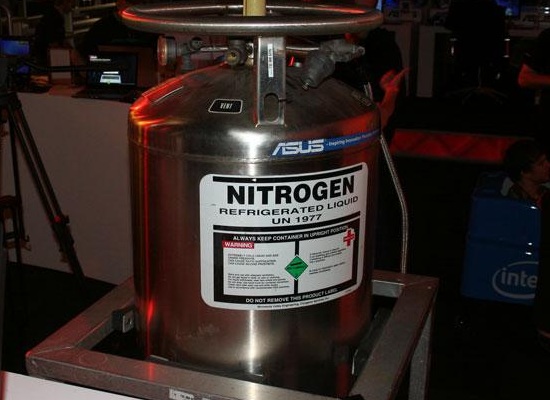 This was the second 200l LN2 container, the first was already empty when this picture was taken |
Last year, Marcus got sick just before the event and couldn’t go. A real bummer for all of us. One of the great things about this is that I get to hang around with him and the rest of the crew doing what we enjoy most, which happens far too seldom. He was still of great help since we stayed in touch throughout the event as he served us with valuable advice and experience (whenever he was able to tear himself from his X-Files marathon). This time we also got company from some friends from Finland (Sampsa Kurri, Pekka Rousu), Norway (Sturla “Stoolman” Haukebø) and Denmark (Thomas “xt0m” Jacobsen and Peter “Nosfer@tu” Kirk). Exchanging experience is important to stay on top as an overclocker.
This year it would be just me and Robert representing NordicHardware. Marcus would also be there, and he would be benching with Robert, but he is no longer a resident writer. We would also be joined by Jon “Elmor” Sandström who have done a lot of benching with Marcus in the past. The fifth and last guy from Sweden would be Öyvind “KnightCharger” Karlsson who would focus on overclocking on air.
Last year we teamed up with Sampsa from Muropaketti, since Marcus was sick, but he’s bringing Petri “SF3D” Korhonen this time. Our old friends from Denmark (Tom and Peter) along with Ivan “vanovich” Gatt, and a new crew from Norway consisting of Haakon “**DP**” Jensen and Øystein “aspstein” Aspøy would join us there to give Nehalem the treatment of a lifetime.
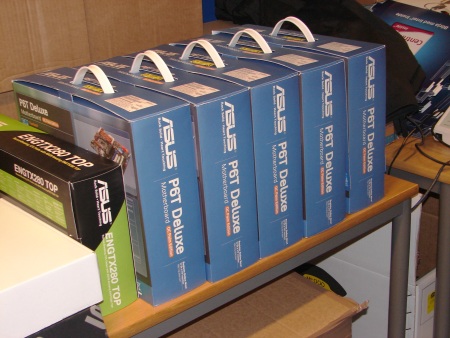 |
So, what about the travel there? Well it started with the fact that I didn’t even get the invitation. It was sent to the wrong address, but luckily Tom notified me and I eventually got it. I almost got worried for a moment. Seeing as myself and Robert are the only ones to have visited Intel two years in a row it would be a real kick in the teeth to break the streak.
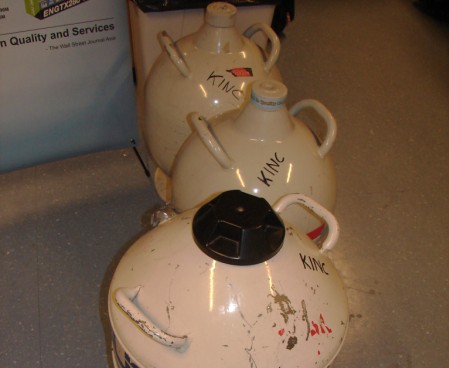 |
I took precautions and this time I’m taking the train from my home town of Pennybridge straight to Stockholm. It’s a two hour trip with only a few stops along the way. Problems should be minimized that way, which is course no fun to you, but I’m getting mighty sick of my heart rate raising to levels of very uncomfortable every time we visit Intel, but then again I’m writing this as I just got on the train. Things can still go horribly wrong.
I texted Robert to see how he was doing and he replied that he’s not feeling so good so he’ll come by tomorrow instead. I sent another message to Marcus checking with him, and he was OK and ready to go. He had been preparing a bit before the event and was already rigged and ready to bench. I was a bit worried about Robert and tried to keep contact to see how he was doing. Perhaps not in the way he would appreciate the most, but you can’t blame a guy for being a bit of a tease.
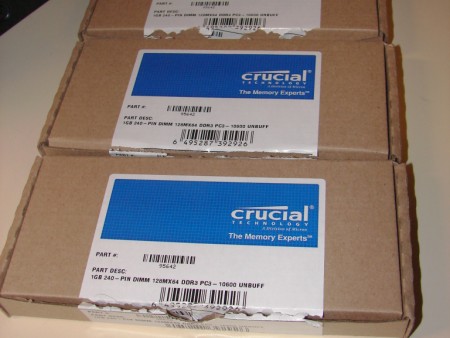 |
The train was on time and I even managed to catch the subway, after having to navigate through the catacombs that are Stockholm Central Station … yea OK, I waited at the strong stop for like 20 minutes or so, but I blame the lack of signs. There are like a ton of “blue” trains going in about the same direction and like six different stops located on three different levels. How was I supposed to know it was the absolute bottom one that was the right one when the coffee shop guy didn’t even know? Bah, I blame him and partially the signs.
Robert was of course not going to be there, but Marcus and Jon was along with our friends from the rest of the Nordics. It wouldn’t be the same without Robert, but since he was going to arrive tomorrow there was little reason to be upset. I navigated to Intel’s office from the stop in Kista and managed to get inside the door with a whole minute to spare. I was on time. It felt weird.
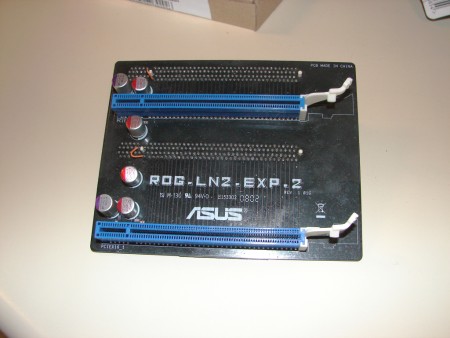
For more space between the slots
|
As it would turn out, Robert had to go to the doctor on Saturday and found out that he had tonsillitis and had to stay home. A real bummer for all of us, but I made sure to send him a teasing get well soon MMS with a picture of the rig up and running. Not surprisingly I got no reply. It’s all harmless fun, Robert has been playing with Nehalem for several weeks since then and I even set him up with some new memory from Corsair now so I think we’re even. I hope so at least?
What about Marcus then? The ASUS office is located 10 minutes from the Intel office. If he hadn’t made it that short stretch, I’m almost certain that I would have blown a funny-fuse. Jon didn’t have much longer.
First of all we all signed the NDA and then we got a group briefing. Luckily Thomas’ laptop had broken down so he did a short oral presentation instead. Basically he told us what we can and can’t say until the NDA lifts: basically no numbers of any kinds. Last year when we said we broke the world record without being able to tell you exactly by how much you were kind of upset so we spared you this rush of feelings this year. We also had other reasons to keep expectations down.
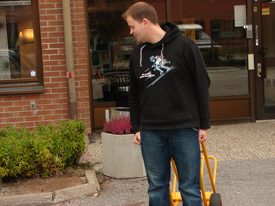 |
 |
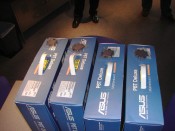 |
|
Presentation and samples being handed out
|
||
The benching started more or less right away since Marcus had done most of the preparations already. It went quite smooth, smoother than previous years. The system booted and Jon and Marcus started by learning more about the settings and how they affected the stability of the system. They used ASUS Rampage II Extreme, which would prove to be a stable platform for Core i7 even though there was still a lot of time before the launch date. Remember that this was almost a month ago, so the (minor) issues we might have had, may not apply to the retail product.
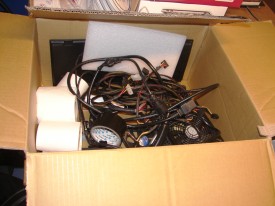
You can never have enough power cords
|
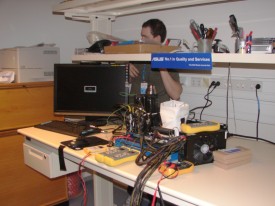
Elmor hiding
|
I should say that the triple channel kit from Corsair, designed for Nehalem, allowed for unimaginable bandwidth. This was most likely one of the first kits in the world and you should really keep an eye for this it, and triple channel kits in general. There is a big difference in the SPD between double channel and triple channel kits, and if the BIOS doesn’t adjust automatically you will want the triple channel kits. The latest BIOSes for the boards used during the weekend, the Rampage II Extreme and the ASUS P6T Deluxe, have this feature, which was very helpful since most of the kits we had were only dual channel kits from OCZ and Crucial.
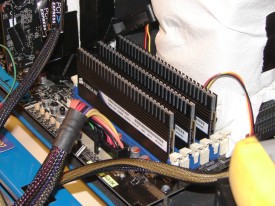
All new triple channel Dominators
|
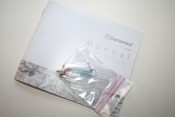
Cooling paste…
|
The bandwidth was measured to way above 20GB/S with the Everest memory benchmark. Next was testing what settings had an impact on memory performance and the conclusion was that latencies didn’t do much for performance but was mainly adjusted for how high you wanted to clock the modules. They did matter and if it was possible to tighten them they were tightened, but overall you will not see the same impact of timings as with an FSB processor.
Overall, overclocking the CPU seemed to have a bigger impact on the bandwidth than overclocking the actual modules. The modules were kept at or near 1GHz, with around 1.6V operating voltage throughout the weekend, but there were occasions where other settings were used in attempts to find new configurations for better performance, but overall it was the regular search for balance between the buses and the memory clock you always have when overclocking. What you should look out for is using dual channel kits as triple channel and keep voltages at below 1.7V (not saying that higher isn’t possible), but you should be careful.
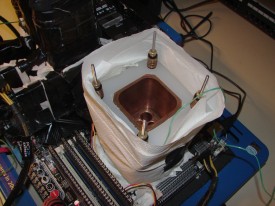 |
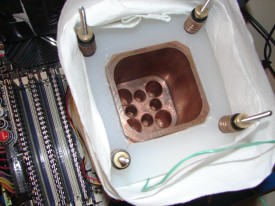 |
During extreme benching like this is it possible to crank up the voltage to 2.0V if you know what you’re doing and make sure to adjust other voltages accordingly. Even if you stick at 1.6V, it will be enough to do 1GHz at CAS9, which results in a bandwidth of about 21GB/s with this system. As you can see the lower memory frequency still results in vastly higher bandwidth than with a FSB system.
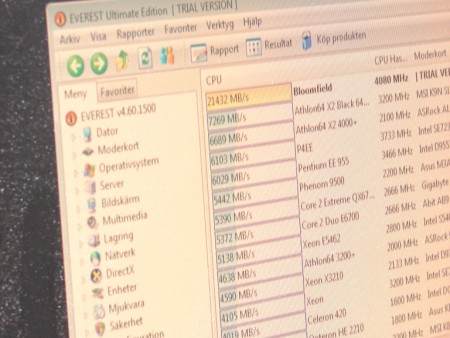 |
If you haven’t read about it before, you will hear it here, over and over: TweakIT is great. ASUS has really done a lot of things right with this tool. The on-the-fly switching between different settings: voltages, frequencies, multipliers and even complete profiles is a must-have for every overclocker. When I say on-the-fly, I do mean on-the-fly. Elmor was the stick controller and was switching voltages, frequencies and multipliers in the middle of running 3DMark Vantage allowing for true optimization of the settings for every game or CPU test.
After getting comfortable with the processor, including the three GeForce GTX280 cards in 3-way SLI, the frequencies were moved up a notch but still playing it safe . The benchmark in question was 3DMark Vantage and foremost the Performance preset. The Core i7 965 processor was operating at 4.67GHz while the graphics cards were still in the safe range of 800/1743/1295MHz. This resulted in a score of P32248 3DMarks. Even though this was a world record by a large margin it was no reason to stop. It had only begun.
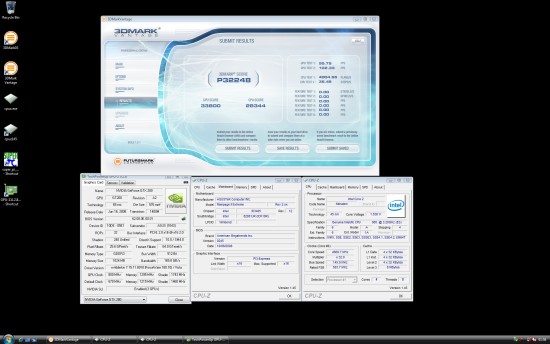 |
The CPU frequency became the focal point while the graphics cards were still at comfortable settings. After some fiddling with the frequencies and testing possible memory ratios and frequencies, the frequency landed at stable 4.8GHz. There was a lot of voltage tweaking going on throughout the weekend, but that was of course because there was still a lot to learn about the system, not so much because it was hard to get it stable, on the contrary. The graphics cards were pushed a bit higher to 850/1900/1295MHz.
Marcus was already quite familiar with the processor, but he hadn’t benched it this hard before to my knowledge. Due to the nature of Core i7, four cores and SMT on top of that, the overall system performance was much greater than with current quad-cores, clearly displayed by the CPU score in Vantage. TweakIT made it easy to overclock the system further without using resource-hogging software or having to enter the BIOS each time. When you learn how to operate the control stick you will love this little tool.
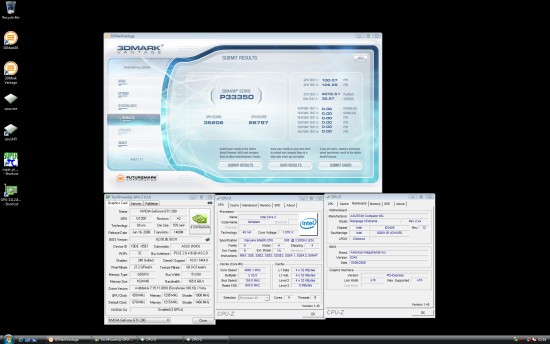 |
At 4.8GHz Jon and Marcus managed to reach P33350, but after tweaking the graphics cards a bit the score improved to P34428 3DMarks, another bump by 1100 points. The graphics cards were tweaked a bit more and just for the fun of it the CPU frequency was pushed a bit as well to 4.87GHz. TweakIT makes it so easy so why not? After some fine-tuning of the voltages and memory settings, the system hit P35401. The streak of 1100 points improvement was broken. At this point Marcus thought that the High and Entry preset should get a hit from the power that is Core i7, and another two world records were blown away. The Entry preset landed at around E65000 3DMarks, while High reached H26000.
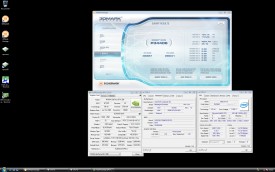 |
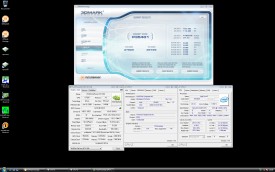 |
The Extreme preset turned out to be harder. Not surprisingly, Extreme is the most graphics intense of the four presets and the current world record is a very good one. When a few drops of water accidentally hit the motherboard and caused what seemed like short-circuit. We decided to take it easy with the graphics cards and focus more on the processor to see what it can do in terms of frequency and SuperPi. The CPU reached 5119MHz and was able to run SuperPi 1M in 8.248 seconds, unfortunately the CPU ran hot after that and the system crashed.
We decided to call it a day and try to get up early instead. The hour was midnight and many of us were tired from the long travels. Three quarters of Sweden and half of Finland decided to head over to the Mr. Chip Hotel, while the Danes and the Norwegians went on for another hour or so.
Jon and Marcus were the only guys that had more than a little experience with running Nehalem, so the other teams needed a bit more time getting accustomed to the new settings. Of course, this is always the case when you get a new motherboard, but this time it was also a whole new microarchitecture to master.
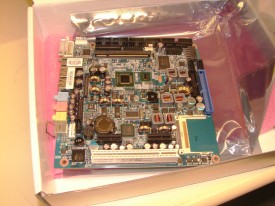
ITX toy brought by Peter
|
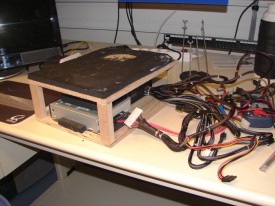
Norwegian techstation
|
Our Swedish colleague KnightCharger did some rather wicked air overclockings during the last event and he had decided to do something similar this event. Unlike us, he would be running two Radeon HD 4870X2 graphics cards in CrossFireX. He, the Norwegians (**DP**, aspstein) and the Danes (xt0m, vanovich, nosfer@tu) all got a Core i7 965 CPU each and an ASUS P6T Deluxe to put it in. Sampsa and SF3D from Finland also got a Rampage II Extreme, but they got their CPU from Intel, while Marcus brought our CPU.
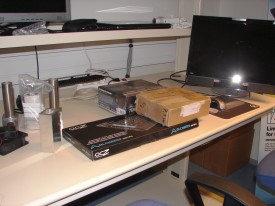 |
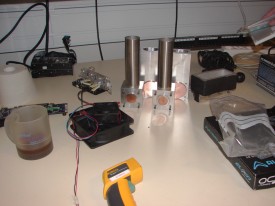 |
Thomas and Ivan had also brought an Intel Core 2 Duo E8600 that was supposed to be good for 6.5GHz and an ASUS P5E64 WS Evolution that was capable of 700MHz FSB. They started off playing with this one, and managed to do quite well. The goal was to break Ivan’s personal best of 8.1 seconds in SuperPi 1M. They managed to go as low as 7.96 seconds with the processor running at 5858MHz. This was in Vista though, the XP installation complained about too many hardware changes…
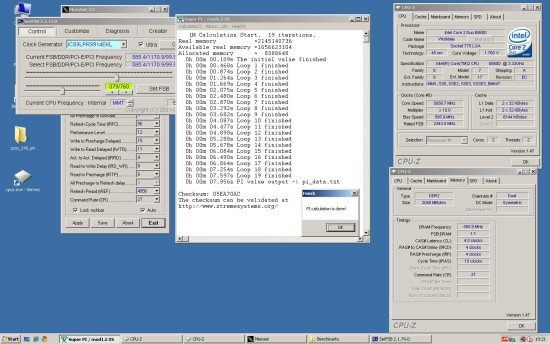 |
The Norwegians started with air cooling and wanted to get a feel for the CPU before throwing nitrogen at it. Unfortunately they experienced the same problems as the Danes and the Fins, that any multiplier over 29x crashed the system. The fins later discovered that disabling two of the cores made it possible to use 30x and above, but that left you with only four working threads in Vantage. This problem may be related to this specific batch and there is nothing pointing to that this is a problem for Intel Core i7 overall.
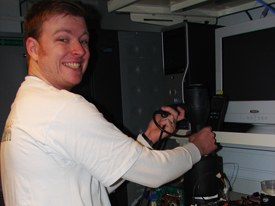 |
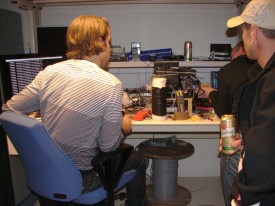 |
| Nosfer@tu doing something, **DP** and aspstein tweaking their system while vanovic watches. Sorry Tom, you seem to have escaped all of my more than 400 pictures. | |
The processor Marcus and Jon used could do up to 34x, 36x in Turbo mode, but after testing even more the processor did seem more stable at 29x, and overclocking the base frequency did yield better performance and better memory ratios. Retail Core i7 965 processors should be a bit better as well, but of course we can’t guarantee this since we haven’t tested them yet. There were also Core i7 940 samples available and even though not all of these were not unlocked they performed very well. They seemed to go higher than some of the 965 samples.
We had decided to meet in the lobby for breakfast at 8AM. I was there 7:50, Marcus arrived at 8:10. He looked just like a person who hadn’t had his coffee yet. I think you know the look. He did wake up though and back in the lab he was the same old Kinc with that look in his eyes where you can actually see him thinking about how we could go even higher, because there isn’t really any frequency high enough. It is just that sometimes you have to settle for less due to time constraints or lack of sleep.
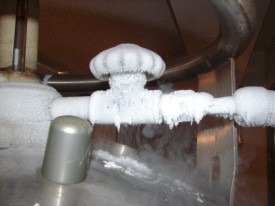
FYI: liquid nitrogen is cold
|
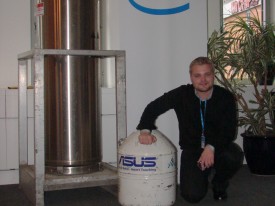
It took some convincing…
|
Day 2 started with refilling the empty dewars, which took forever for some reason. The liquid was pouring very slowly from the first container. When we thought we had emptied out the first 200l container we tried the second one, but it refused to release anything at all. We decided to try and unscrew the nozzle at the end of the hose, but for that we needed bigger pliers. So we sent out Elmor to get some at the hardware store at the mall. It is like a five minute walk to the mall. Elmor returned a whole hour later.
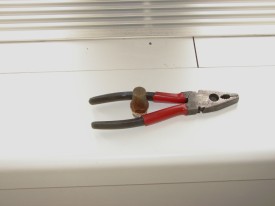
Evil …
|
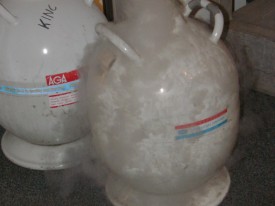
Flowing again
|
It seemed that we might have been a tiny bit wrong about the opening hours. The store opened at 10, not 9 like we said. He walked over there 9:10, but since it was closed he decided to head over to the gas station 500 meters over to check if they had any pliers, but no. He went back to the hardware store and waited for another 15 minutes until they opened. When the hour was quarter to ten I started worrying if he had got lost at the mall, but since he’s from the area that seemed very odd. When he came back and told us that it hadn’t opened until 10, we all got a good laugh, well except Elmor of course. We laughed and apologized.
In the meantime Kinc had started benching again with the nitrogen we had extracted from the first 200l container. With the new pliers we got the nozzle off and the liquid nitrogen was flowing like never before. We filled up the last of the three dewars and Elmor could return to benching with Kinc. We even got some more LN2 out of the first container before deciding to call it empty. The benching started and even though the platform did feel stable, there is no way to avoid the occasional Blue Screen Of Death at this level of overclocking;
Sampsa: The colors of the Finnish flag.
Marcus: What?
Sampsa: Blue and white colors on your screen.
Marcus: So that’s why you have that over on your screen all the time.
*Everyone laughs*
Sampsa: Yea, it’s to keep up the team spirit. Blue screens and the Finnish national anthem.
The benching continued with trying to push the 3DMark Vantage Performance preset and test the limits of the CPU. It was working at or around 5.0GHz when the score finally landed on 35,763 3DMarks. It is not easy trying to document the exact frequencies when it changes throughout the run. I sighed for myself at one point because I couldn’t quite keep up with what the heck they were doing. TweakIT enabled Jon to switch settings so fast, and Marcus is always completely aware of what is happening with the system, much unlike his orientation while driving. I must have misplaced my mind reading ability, because they surely seemed to do some sort of communication I couldn’t pick up.
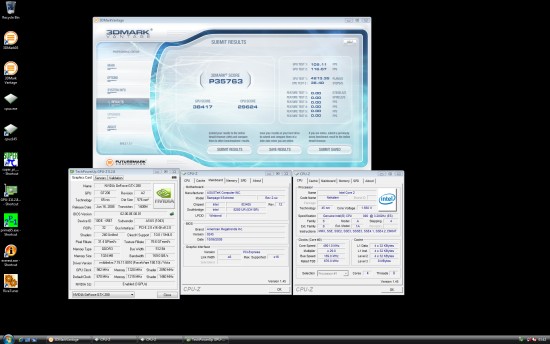 |
The CPU clock was lowered to 4.9GHz for the CPU tests (that’s why the CPU-Z says 4.9 instead of 5.0). The graphics cards were now nearing their limits with a GPU clock of 983MH, shaders running at 2050MHz and the memory operating at 1320MHz. The score from the Entry Preset was improved to E67207 and that was the second and last run we did with Entry. From now on the focus was on the Performance and Extreme. First of all the Performance preset since this is the main preset of Vantage, mainly because this is the only preset you upload results to the ORB with if you’re running the cheapest 3DMark Vantage client.
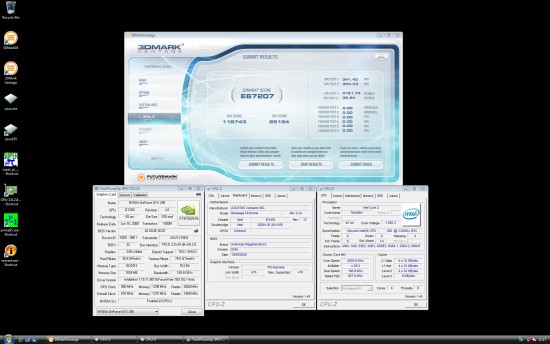 |
I also made sure to check in the other guys now and then since there were in a different lab. Intel had now divides us into two groups, Sweden (Me, Kinc, Elmor) and Finland (Sampsa, SF3D) in Lab 1 Valhalla, while Norway (**DP**, aspstein), Denmark (xt0m, vanovich, nosfer@tu) and our Swedish air overclocking colleague KnightCharger was in Lab 2 Midgård (middle-earth).
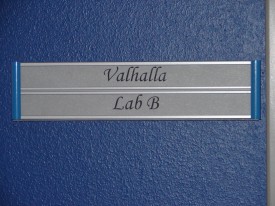 |
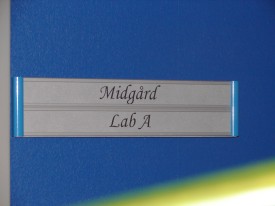 |
Elmor was very eager to get to 36,000, but Marcus was more interested in trying Extreme. The battle of the wills had begun. It was a short one and it turned out that the elder of the two would get the last say and the preset had now been changed to Extreme. Alas, the graphics cards had been up and running for many hours now and the cold was starting to result in some weird behavior and lockups. Eventually it was decided to build a hot fan oven from an hair dryer and a carbon box to heat up and dry the graphics card for a bit.
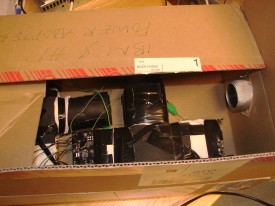
Hairdryer + carton = win
|
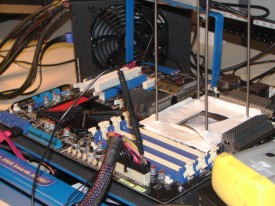
Rig down
|
About the same time the photographer from Metro Teknik, arrived and wanted to take some shots. Our system was disassembled, but Sampsa and SF3D was still benching at full capacity so she got some photos of them benchmarking, with Kinc doing his “drinking liquid nitrogen” bit in the background. She also took some pictures of me, Mean Machine and our host Thomas filling up a dewar with fresh nitrogen. We decided to wait and eat dinner before starting again, which would also give the hardware some well deserved rest before we would give it one last try.
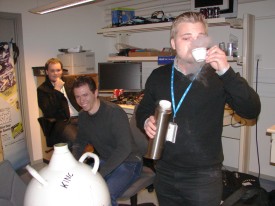
Marcus shows off …
|
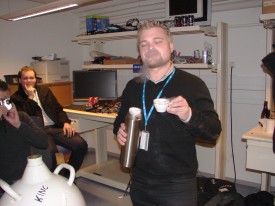
… his party trick
|
After filling up on the very delicious catering food from Helt Klart Gott, they really deserve a mentioning here after serving us with some of the most delicious catering food I have tasted. The roast beef and potato au gratin was excellent. I suggested a short nap, but was just stared at or ignored in favor of giving the hardware one last whip.
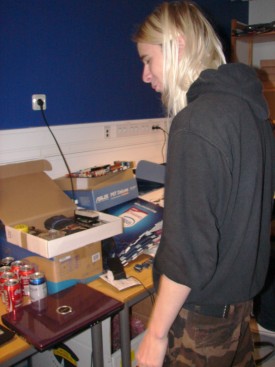
*BLEEP* *BLEEP* laptop *BLEEP*
|
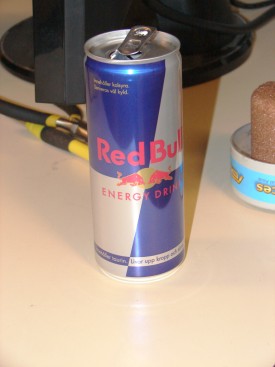
Red Bull was consumed
|
Earlier during the day, fellow editor Jonas “Mean Machine” Klar arrived and brought his Core 2 Duo E6320 that had been showing promise and decided to test it under sub-zero temps. He borrowed the ASUS P5E64 WS Evolution motherboard from Tom, but unfortunately the board did not have settings for high enough voltages. A processor voltage of 1.9V is nowhere near enough when you want to reach really high FSBs. Still, he managed to reach 591MHz FSB, which has to be considered OK, even though I was humoring him a bit and saying the he should go another 60MHz or so before we should call it really good.
I divided the pictures from Day 2 into two categories: before 18 and after 18. The break was when we had dinner. There was one major problem approaching. Sweden and Portugal was playing in the world cup qualifier (that’s soccer). Somehow I had to juggle the game and keeping track of the benching. Thomas had arranged for me to watch the game on the big screen out in the dining room, but since I came here to be a part of the overclocking and I was eager to find a way to watch the game while still being in the lab.
I managed to get a feed running on my laptop and I was set to go. Thomas was a bit upset since he had actually set up the game for me to watch out in the diner, but we managed to reach an agreement where I would not have the sound up to high since he was also filming now. I seriously hope that the video will never reach the hands of anyone else. Internal jokes should perhaps stay internal; they are only funny to the initiated. Safe to say, we had a blast.
I borrowed a pair of headphones from one of the gaming systems Thomas had brought so I wouldn’t disturb the filming process. My memory of what Marcus and Jon was doing is a bit fuzzy here since I was not only watching the game and writing on this article, we were also consuming liquids of the kind not suitable for a site supposedly rated PG-13.
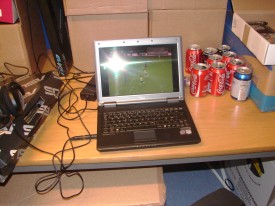
Portugal should celebrate the draw
|
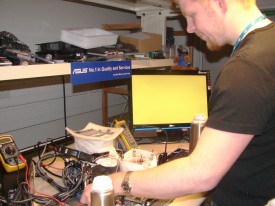
Don’t mess with Swedes, we have eerie powers
|
When Sampsa started cheering for Portugal he and SF3D was served with the much less known big blank yellow screen of death (one of the colors of the Swedish flag). Even though I have no exact knowledge of what the heck might have caused it, almost certain it was Zlatan Ibrahimovic (Swedish attacker for you non-soccer fans) that had heard him through the TV and retaliated. Later on Marcus was moving around the room humming “Simply the best”, no one seemed to object.
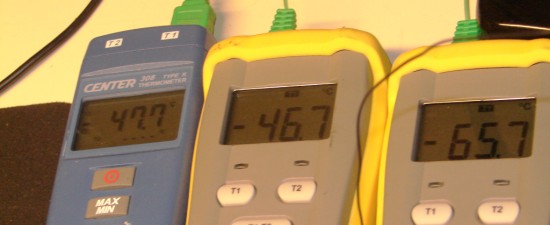
Graphics card temperatures
|
What I also remember is Marcus asking Jon what my priorities were as they were getting closer to the end of a very promising run with the 3DMark Vantage Extreme preset. Even though I enjoy watching soccer, the game was tied 0-0 with Sweden having the best chances and things didn’t look like they would change, so I got up and watched the final CPU test run to completion and the score pop up: X21602. The graphics cards were now up to near 1GHz core clocks and the CPU had been doing near 5GHz in the game tests, and 4.9GHz during the CPU tests.
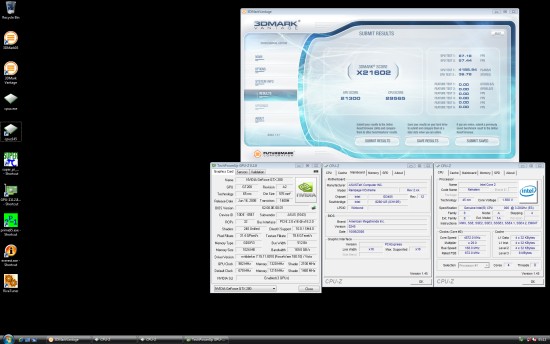 |
A record I wasn’t so sure that we would be able to break had been shattered. Just to follow up we ran the High Preset and scored H29029. Probably the score that impressesed us the most … well maybe tied with the Extreme preset score.
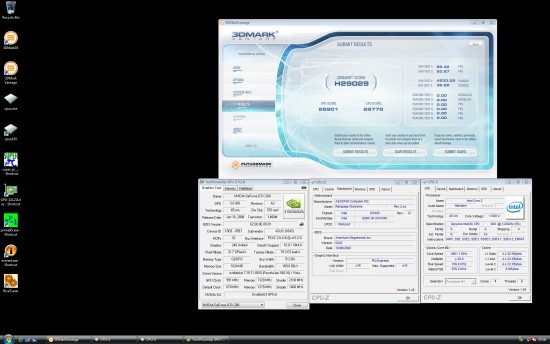 |
While we were struggling to go that extra mile for reaching those world record results, the others were starting to catch up to us. The Sampsa and SF3D had switched motherboard to ASUS P6T just to realize that it was the CPU that was the culprit. They switched back to the Rampage II Extreme and later tried a new processor, Core i7 940, that worked better. It was unlocked and had an older stepping that seemed to provide better peak frequencies overall. They could now move past the measly 4.4GHz and start pushing up the frequency.
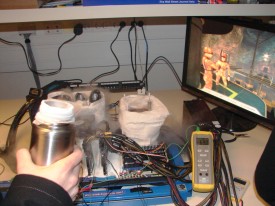
SF3D and Sampsa in action
|
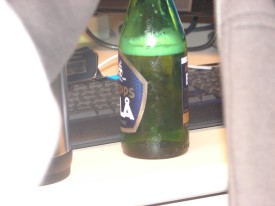
“It tastes like rubber band”
|
They managed to climb higher and seemed to have found a good spot at around 4.7GHz where they eventually scored around P32663 3DMarks with the graphics cards clocked at 870/1900/1280MHz. They decided that this was good enough and move on to benching Cinebench and SuperPi 1M to get some results there as well. A round of Cinebench R10 was completed at 4752MHz, which resulted in a score of 20036 points. SuperPi 1M was stable up to 4960MHz, which got them 8.343 seconds.
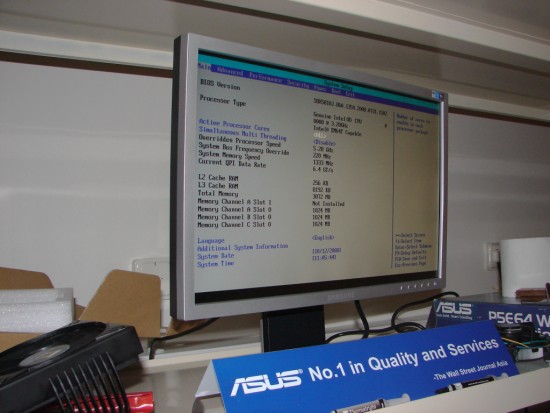 |
The highest clock achieved during the weekend, although a just a BIOS shot, was achieved by the Danes that hit 5.28GHz. The system was not stable though, but we would not be surprised if we see 3D stable speeds over 5GHz soon.
So … four world records were broken. We didn’t set out with any real goals. We were of course hoping that things would work out well, but if we didn’t manage to leave any significant marks at this event, we wouldn’t be saddened by it. It takes time to learn a new architecture and processor. Even though Marcus had been playing with it before the event, I’m sure he will continue doing so after this to learn even more about it.
From our former visits at Intel and all the live overclockings we have learned to keep the expectations at a minimum and instead focus on just having fun. If you set out with the goal of breaking so and so many world records you’re really doing if for all the wrong reasons and are going to make mistakes that will cost you valuable time and hardware. It all comes down to pushing the limits of what the hardware can do and finding new ways of doing it.
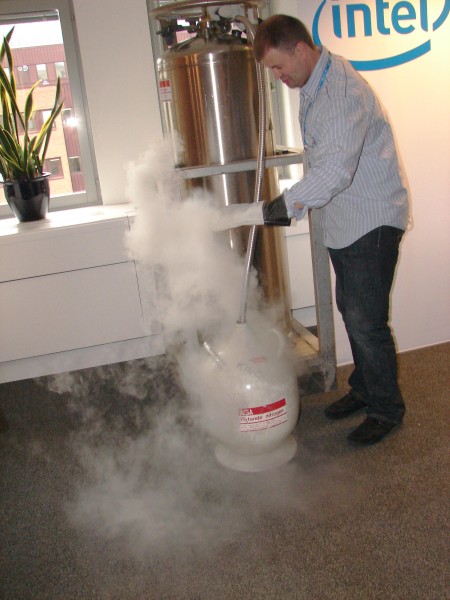
The one and only
|
Whether it is a 3DMark world record or not is not really the issue, it’s how you have been able to push the hardware to levels of speed that the manufacturer did not nearly expect. Unfortunately this becomes harder by the minute since most hardware manufacturers are literally expecting overclocking and preparing the hardware to be overclocked. They even do it themselves sometimes. Unfortunately the world records are needed. Without them overclocking would get little attention in the media.
A weekend of liquid nitrogen and hanging with computer nerds maybe isn’t what you consider fun, but maybe then you should take a step back and realize you just read 14 pages about just that. Like I said earlier, we had a blast and can’t wait for next year and Sandy Bridge. We want to thank Intel and our demigod Thomas most of all for arranging this. We know that he puts a tremendous amount of his free time and money into making this event happen and we are ever so grateful.



